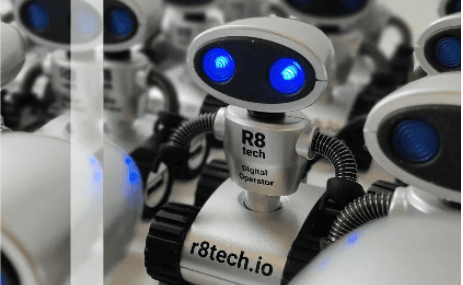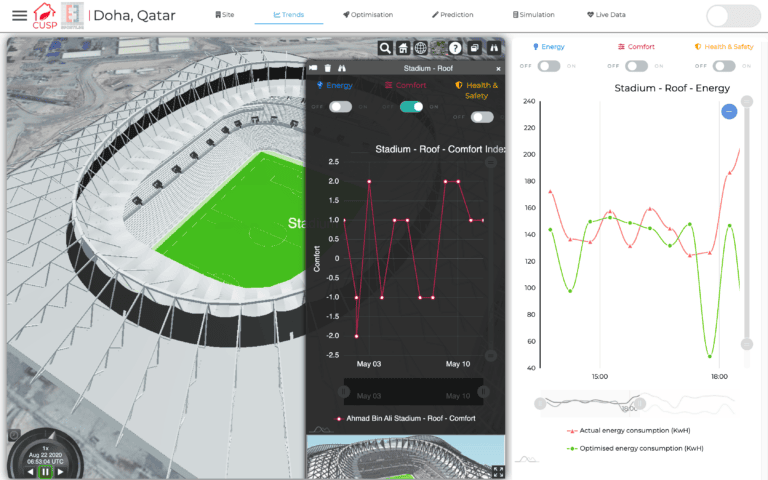Autonomous control of HVAC

Problem Addressed
The energy required to heat, cool, and power our buildings is responsible for 19% of the UK’s carbon footprint. With UKGBC’s Whole Life Carbon Roadmap targeting a 49% reduction in non-domestic energy intensity by 2040, optimising the energy use of existing commercial buildings is an important strategy to reduce emissions. HVAC systems are responsible for a significant portion of the energy consumption in commercial buildings, but often operate inefficiently and lack optimisation leading to unnecessary thermal and electrical energy consumption. This also impacts the maintenance factor and operating conditions of HVAC systems, resulting in shorter predicted lifespans and operational efficacy. This lack of optimisation can also lead to issues with occupant thermal comfort, indoor air quality, building fabric protection and health and well-being.
The table below includes information about many of the solutions in this area with information provided by the solution provider. Please click on the company names to see more information about each solution.
| Company name | Solution overview | Building type | Input Data | Load Shifting | Building systems controlled | Pricing model | Stage of development |
|---|---|---|---|---|---|---|---|
| BrainBox AI | Core HVAC solution uses advanced AI algorithms to make buildings smarter greener, and more efficient. (1) 4-connectivity methods: cloud connected thermostats, Niagara Framework, Cloud to cloud integration, and BACnet (2) AI-ready energy management system (EMS) optimises HVAC energy consumption via HVAC scheduling and setpoint management (3) ARIA – genAI virtual building assistant, leverages diverse data sources to generate the most impactful insights for building management | Industrial, office, retail, social infrastructure | BMS, weather data, utility tariff structures, occupancy data, grid emissions rates | Yes | HVAC | Monthly fee | Solution found in 14,900 buildings in over 20 countries |
| Elyos Energy | Connects to the BMS via an edge device and do two types of optimisation: (1) ‘Read only’: anomaly detection and sends automated alerts to instruct the building manager to make changes. (2) ‘Read and write’:takes control of the scheduling and can turn the ventilation system on and off at the optimal time each day given the weather and occupancy conditions | Offices, hotels, shopping centres, universities, leisure centres, schools, data centres, government buildings, warehouses | BMS, weather data, occupancy and site energy behaviour | Yes | HVAC and all distributed energy resources including EVs, solar and smart thermostats | Monthly fee | Being used in over 400 buildings |
| Hank (by JLL) | Works by keeping the original BMS hardware but utilising all necessary physical inputs and outputs and integrates them into the Hank infostructure. (1) Use cloud-based AI (bespoke ML technologies) and bespoke digital twins to provide extra control, control forecasting, intelligent alarms and long-term data monitoring and storage, retrievable via the Hank UI. (2) Provide client oversight, control, setpoint adjustment and scheduling through a web-based user interface (HANK UI). (3) Local equipment (Hank Edge device) is installed which provides everything needed during any external network outages/interruptions, allowing equipment to continue to function 24/7. (4) Full support team of HVAC/BMS engineers working 24/7 that can instantly advise, adjust and control equipment over a phone call or via email | Office, retail, industrial, new build, refurbishment | BMS, weather data, occupancy and predefined optimisation strategies | No information | HVAC | One off set up fee and monthly fee, guaranteed energy savings will always exceed subscription cost | No information |
| Optimise AI | Minimises energy consumption and carbon emissions via patented digital twin technology. (1) Provides actionable insights and control for buildings that only have a meter, through to those that are highly instrumented. (2) Autonomously controls HVAC systems via meter/sensor data coupled with building physics models and AI trained operational data models | Airports, Offices, Manufacturing, University Campuses, Hotel, Rail, Retail, Leisure facilities | Meter readings, with greater insights available with data such as occupancy, temperature, CO2, Energy Tariffs etc | Yes | HVAC, Lighting, Machinery, Industrial Processes, Renewable Energy Optimisation, Water, Air Quality Optimisation | Free building energy MOT, with premium services. Plus ability to upgrade to full digital twin (monthly SaaS) | Piloting with clients such as Network Rail, Luton Airport, Scot Rail, Exchange Quay, University of Wales |
| R8 Technologies | A remote and safe connection (no additional hardware needed) with BMS enables R8tech AI-based SaaS to read, monitor, analyse, calculate and write back new settings to HVAC systems (every 15 minutes if needed) to ensure the required indoor climate with minimum costs. All the external factors with an impact are taken into account as well for a higher proactivity level. Also – always the clients have a right to act with a higher priority if they like. Diagnostics algorithms detect technical faults and anomalies and turn these to actual tasks and monitored by AI during the maintenance process. This gives a novel transparency about building’s technical systems health and increases technical management efficiency and system lifecycle remarkably | Hotels, office, residential, retail, social infrastructure | BMS, weather data, occupancy, and energy market prices | Yes | HVAC | Monthly fee or outright purchase | In use by 40,000,000sf of CRE in 23 countries across Europe + Japan (as of 01.01.25) |
| REsustain | Specialises in creating calibrated Digital Twins—real-time virtual replicas of buildings that centralise operational data to drive significant energy efficiency improvements and carbon reduction. Built on the EnergyPlus™ model, these Digital Twins establish precise energy baselines, serving as foundational tools for performance management and optimisation. By democratising access to this technology, re:sustain enables property owners and stakeholders to adopt powerful decarbonisation solutions quickly and effectively, shifting the paradigm by remotely optimising assets through existing controls—without the need for CAPEX. This approach extends asset life and mitigates stranding risks by up to 10 years. Their models also facilitate long-term CAPEX planning, offering tailored and scalable decarbonisation strategies for both individual buildings and entire portfolios | Office, Industrial, Retail, Hotels, Higher Education | Weather data, carbon data, BMS, utility, ML modelled data, process data, & property data | Yes, optional offering | All BMS controlled systems | SaaS model – one off set-up fee and annual recurring fee thereafter | Mature platform with scaling client base across core market (UK & EU) with average energy savings at 34% in the first twelve months of adoption |
| LightFi | Save energy and improve building comfort with advanced sensors designed for Demand Control Ventilation | Any building with mechanical ventilation, typically found in any office, airport, university commercial building over 50,000 square feet | Sensors measure air quality and count people in a number of different ways | Automatically allows buildings to use less energy during natural grid peak times, but cannot currently be monetised | Air handling units, fan coil units (anything with a fan), all controls are via a traditional BMS | Mostly CAPEX with a small annual subscription | Implemented on a number of large commercial buildings, scaling up through the UK |
This page presents data, evidence, and solutions that are provided by our partners and members and should therefore not be attributed to UKGBC. While we showcase these solutions for inspiration, to build consensus, and create momentum for climate action, UKGBC does not offer commercial endorsement of individual solutions. If you would like to quote something from this page, or more information, please contact our Communications team at media@ukgbc.org.
Related
Occupancy sensors to optimise energy efficiency

AI-empowered autonomous HVAC control

Building Optimisation Software Using AI and Digital Twins

HVAC Optimisation and Management


